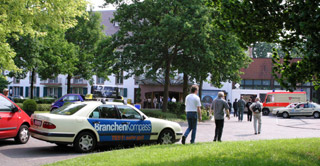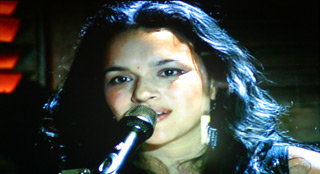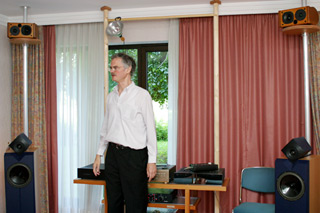![[SoundStage!]](../sslogo3.gif) The Traveler The TravelerBack Issue Article |
July 2003 German Lessons
Now don’t get me wrong -- I’m not some dinosaur still clinging to a format like vinyl and pretending that it’s about to make a resurgence. And I don’t have some strange attachment to two-channel playback and think that because I have two ears that I only need two speakers. What I am is a publisher, writer, and audiophile looking from the outside in at the future of DVD-A and SACD and their multichannel capabilities and finding absolutely no compelling reason to even consider buying an advanced-resolution player to use as a multichannel source (along with all the speakers and amplifiers to go with it). My DVD-Video player at the heart of my home-theater system is doing quite well, thank you very much, because that industry actually gets it. Let me explain. DVD-V gets it Look back to the opening paragraph and you’ll see the term "video-less" -- that’s what DVD-A and SACD are, or, perhaps, are limited by. The DVD-V people are already offering multichannel music and video, and they're selling products in that format like McDonald’s is selling hamburgers. Who knows how many millions, or billions, the DVD-V people will serve in the coming years. SACD and DVD-A aren’t even on anyone’s menu, and if the SACD/DVD-A people don’t get their acts together, DVD-V might just knock them both out. Farfetched?
Live in New Orleans doesn’t have a lot of extras, as many DVD-Vs have, but here’s the clincher: It’s cheap. I paid 16 Canadian dollars for it (that’s about 11 US dollars). So, for about the same price as lunch for two at McDonald’s, you get good video and sound and music in a format that you already know and understand and likely are using at home -- thanks to the great marketing campaign behind the launch of DVD-V in the first place. SACD and DVD-A don't get it By comparison, SACD and DVD-A are nowhere, and I’m expecting that their logos are going to show up on the back of milk cartons someday (along with the cover images of a number of the audio print magazines -- but that's another story). In my last "Traveler" feature, "High-End Audio 101," I wrote about discussing DVD-A and SACD with a high school class, and they didn’t really have a clue what I was talking about. For all intents and purposes, these were news -- and not necessarily important news. Had they heard about DVD-V, CD, and MP3? Yup, yup, and yup. They're hardly unique. Go to your local record store and start asking about DVD-A and SACD and see how many employees clue in. Nobody outside of the audiophile world even knows that SACD and DVD-A exist. And don’t kid yourself that those who have bought into them in the audiophile world amount to much. I’ll betcha Britney Spears alone has sold more CDs than all artists combined on DVD-A and SACD. How could this happen? Simple: in-fighting, and no one is bothering to look ahead. The DVD-A and SACD people have been spending so much time fighting over which of their formats is better (and that’s still up in the air) that they’ve forgotten to actually sell the idea of this new format to the public. Remember when CD first came out, the words "Digital," "Digital Sound," and "Digital Ready" were emblazoned on everything, and consumers were told that when they saw the word "digital" it didn’t just mean better sound, it meant perfect sound -- forever. For better or worse, from a marketing point of view, it worked, and people snapped up CDs. Before long, LPs and cassettes were virtually dead. Look today at an SACD or DVD-A package and you don’t see big words promoting anything, but you might see a cryptic warning (yes, a warning!) that you’ll need a special player to play the disc if you lay down the big bucks to buy it. Inviting, huh? If you’re lucky, somewhere you might see tiny words that say "Advanced Resolution," but what exactly does that mean? These are hardly selling features -- and there's nothing there to help understand the medium. So today what we have are relatively few multichannel-music-only releases in formats that no one has even heard of, released in packaging not all that much different than that of a CD, with no video image, and usually costing a premium price. Wow, what a well-thought-out concept. Hold back the stampede of buyers. It’s obvious that the folks marketing these products don’t have their act together, but they’re not the only ones in that camp to blame. I’m not sure the people who wrote out the technical spec for DVD-A and SACD really thought it out either. They've built their coffin; hand 'em the nails I went to Sony’s demonstration in Frankfurt and sat amidst five speakers similar to what I would see in any home-theater system, but with a big difference: There was no video screen. Remember, this is video-less multichannel music -- something that offers less than DVD-V, but proponents expect the consumer will understand why he's paying more for it. Then they played about five selections of which one sounded really good, one was quite bad, and three were OK -- and in the end they were all less involving than Norah Jones, and there certainly wasn't a pretty face to look at either. Wait, it gets worse.
I don’t believe 2+2+2 is actually going to go anywhere; it’s more of a novelty than anything. Besides, the people behind it have no marketing clout, and even fewer people than have heard DVD-A and SACD will ever get the chance to hear a 2+2+2 setup. But it's relevant enough to take notice that something more should have been done. Too bad this company didn’t have any say in the original DVD-A or SACD specs. Instead, DVD-A and SACD were created by a bunch of guys who thought that promoting conventional five-channel surround sound was a good idea -- after the movie industry blanketed the market with low-cost DVD-V players and cheap software with all kinds of frills. In order for either DVD-A or SACD to really take hold, the formats are going to have to offer the three Ps: performance, packaging, and price. Right now SACD and DVD-A score a big fat ZERO in all departments -- and no, Norah Jones' Come Away with Me on Multichannel SACD isn't going to help much. And this makes me wonder: If they can’t interest an audiophile like me in their new technology, who do they expect to buy it? ...Doug Schneider
|
|
![[SoundStage!]](../sslogo3.gif) All Contents All ContentsCopyright © 2003 SoundStage! All Rights Reserved |
 It took a seven-hour plane
ride and a single cab ride at the end of May to Frankfurt’s annual High End show to
realize that video-less multichannel music is about as close to mass acceptance as
Adam Sandler is to getting a Best Actor Oscar. (Although after seeing Punch-Drunk Love,
if forced to bet, I’d put my money on Sandler.)
It took a seven-hour plane
ride and a single cab ride at the end of May to Frankfurt’s annual High End show to
realize that video-less multichannel music is about as close to mass acceptance as
Adam Sandler is to getting a Best Actor Oscar. (Although after seeing Punch-Drunk Love,
if forced to bet, I’d put my money on Sandler.) The most-played
surround-sound music in Frankfurt was Norah Jones’ DVD-V Live in New Orleans
-- and it’s no wonder why. The 15 selections are all good, and the image is
interesting to watch along the way. Included on this DVD-V are two-channel and 5.1-channel
mixes, and although they’re not to the same fidelity as a really well-recorded CD,
they’re surprisingly good and wholly acceptable for most people. Even hardcore
audiophiles like Jeff Fritz and I concurred that Live in New Orleans sounded pretty
darn good on a number of systems.
The most-played
surround-sound music in Frankfurt was Norah Jones’ DVD-V Live in New Orleans
-- and it’s no wonder why. The 15 selections are all good, and the image is
interesting to watch along the way. Included on this DVD-V are two-channel and 5.1-channel
mixes, and although they’re not to the same fidelity as a really well-recorded CD,
they’re surprisingly good and wholly acceptable for most people. Even hardcore
audiophiles like Jeff Fritz and I concurred that Live in New Orleans sounded pretty
darn good on a number of systems. Down the hall a German company called MDG was promoting 2+2+2, a proprietary
recording and playback method they’ve developed. What MDG has done is taken DVD-A
technology and realigned some of the channels. They’re using what was the
center channel for a left "height" channel, and they are using the subwoofer
channel for a right "height" channel. For these height channels, they mounted
two smaller speakers a few feet above the corresponding front main speakers. Surprisingly,
the result was far more interesting than almost anything I’ve heard from DVD-A or
SACD. Most importantly, with the 2+2+2 system, there was a noticeable increase in
spaciousness and dimensionality, which was quite a bit different than what you get
from DVD-A and SACD, and, of course, regular Dolby Digital- and DTS-type surround sound
that you find on DVD-Vs. In other words, these 2+2+2 guys have something unique to sell,
even it they’ve simply cobbled together their system out of the DVD-A spec.
Down the hall a German company called MDG was promoting 2+2+2, a proprietary
recording and playback method they’ve developed. What MDG has done is taken DVD-A
technology and realigned some of the channels. They’re using what was the
center channel for a left "height" channel, and they are using the subwoofer
channel for a right "height" channel. For these height channels, they mounted
two smaller speakers a few feet above the corresponding front main speakers. Surprisingly,
the result was far more interesting than almost anything I’ve heard from DVD-A or
SACD. Most importantly, with the 2+2+2 system, there was a noticeable increase in
spaciousness and dimensionality, which was quite a bit different than what you get
from DVD-A and SACD, and, of course, regular Dolby Digital- and DTS-type surround sound
that you find on DVD-Vs. In other words, these 2+2+2 guys have something unique to sell,
even it they’ve simply cobbled together their system out of the DVD-A spec.